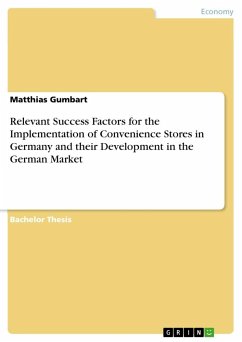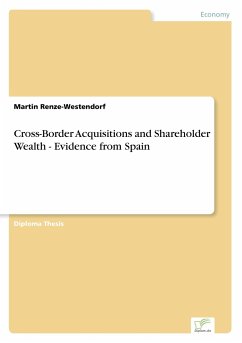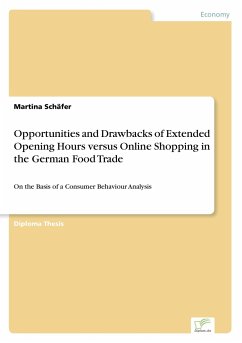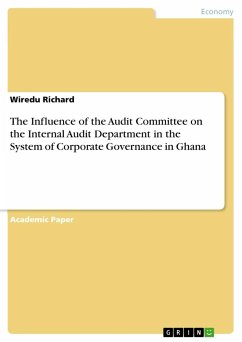
Comparative Analysis of Department Stores and Shopping Centers in Germany and Spain
Versandkostenfrei!
Versandfertig in 1-2 Wochen
68,00 €
inkl. MwSt.

PAYBACK Punkte
0 °P sammeln!
Master's Thesis from the year 2006 in the subject Business economics - Trade and Distribution, grade: 3,0, Otto-von-Guericke-University Magdeburg (Fakultät für Wirtschaftswissenschaft), course: Internationales Management, language: English, abstract: Inhaltsangabe:Abstract:Why are traditional German department stores close to bankruptcy in a time when so many new shopping centers with a similar offering of goods are being built? Is this phenomenon just a problem of German companies or do other countries have the same situation? For comparison, the situations in different countries, Germany a...
Master's Thesis from the year 2006 in the subject Business economics - Trade and Distribution, grade: 3,0, Otto-von-Guericke-University Magdeburg (Fakultät für Wirtschaftswissenschaft), course: Internationales Management, language: English, abstract: Inhaltsangabe:Abstract:
Why are traditional German department stores close to bankruptcy in a time when so many new shopping centers with a similar offering of goods are being built? Is this phenomenon just a problem of German companies or do other countries have the same situation? For comparison, the situations in different countries, Germany and Spain are picked.
Most of the literature in the field of retail management is written about US American companies. Thus, this thesis cannot totally ignore it. E-commerce, despite its growing importance, is not part of this comparison, as both retail formats are faced with the same opportunities and threats by it.
The starting point of this thesis is the difficult situation Karstadt was facing in the last two years and the story about the successful department store concept of El Corte Inglés in Spain; hence these two companies play a major role throughout this thesis.
The introduction provides the reader with an overview of the thesis. Furthermore, the question is addressed, if department stores and shopping centers can be compared.
The main body of this thesis consists of three parts, which are structured after the same pattern: country level, industry level and company level. First, data is collected for a later analysis. Chapter 2 gathers all relevant information about Germany and Spain and then narrows down to the history of department stores and shopping centers. The company data is shown in its own chapter 3, as a major part of this thesis should be the company comparison of Karstadt and El Corte Inglés. The market leaders in the respective markets are shown in case studies and complemented by data of the two companies that emphasizes the finalanalysis and conclusion.
The theoretical background of company analysis is given in chapter 4. Again, the first part about the macro environment concentrates on the country level. Then, the micro environment forces comparing the attractiveness of industries are explained. The last part contains the fundamentals of the internal environment analysis, which reflects the company level.
In chapter 5, the findings are used to construct profiles, point out differences between the different countries, industries and companies, and to find ideas for improving the existing management strategies of the given companies.
The conclusion not only provides a summary of the thesis, it also gives a forecast and identifies sources and possibilities for further research.
Inhaltsverzeichnis:Table of Contents:
List of FiguresVI
List of TablesVII
List of AbbreviationsVIII
1.Introduction1
1.1Overview1
1.2Comparing Department Stores and Shopping Centers3
2.Data Collection6
2.1Countries6
2.1.1Germany6
2.1.2Spain8
2.2Large-Scale Retailing11
2.2.1Department Stores12
2.2.2Shopping Centers15
3.Case Studies20
3.1Karstadt Warenhaus/Karstadt Quelle20
3.1.1History20
3.1.2Karstadt s Crisis22
3.1.3Facts and Figures23
3.1.4Forecast24
3.2El Corte Inglés27
3.2.1History27
3.2.2Facts and Figures28
3.2.3Forecast29
3.3ECE Projektmanagement30
3.3.1History30
3.3.2Facts and Figures32
3.3.3Forecast33
3.4Sonae Sierra/Sonae SGPS33
3.5Excursus: Galeria Kaufhof/Metro Group34
3.6Excursus: ALDI35
4.Strategic Analysis38
4.1External Environment Analysis39
4.1.1Macro Environment Forces41
4.1.1.1Political Factors41
4.1.1.2Economic Factors42
4.1.1.3Socio-cultural Factors43
4.1.1.4Technological Factors44
4.1.2Micro Environment Forces44
4....
Why are traditional German department stores close to bankruptcy in a time when so many new shopping centers with a similar offering of goods are being built? Is this phenomenon just a problem of German companies or do other countries have the same situation? For comparison, the situations in different countries, Germany and Spain are picked.
Most of the literature in the field of retail management is written about US American companies. Thus, this thesis cannot totally ignore it. E-commerce, despite its growing importance, is not part of this comparison, as both retail formats are faced with the same opportunities and threats by it.
The starting point of this thesis is the difficult situation Karstadt was facing in the last two years and the story about the successful department store concept of El Corte Inglés in Spain; hence these two companies play a major role throughout this thesis.
The introduction provides the reader with an overview of the thesis. Furthermore, the question is addressed, if department stores and shopping centers can be compared.
The main body of this thesis consists of three parts, which are structured after the same pattern: country level, industry level and company level. First, data is collected for a later analysis. Chapter 2 gathers all relevant information about Germany and Spain and then narrows down to the history of department stores and shopping centers. The company data is shown in its own chapter 3, as a major part of this thesis should be the company comparison of Karstadt and El Corte Inglés. The market leaders in the respective markets are shown in case studies and complemented by data of the two companies that emphasizes the finalanalysis and conclusion.
The theoretical background of company analysis is given in chapter 4. Again, the first part about the macro environment concentrates on the country level. Then, the micro environment forces comparing the attractiveness of industries are explained. The last part contains the fundamentals of the internal environment analysis, which reflects the company level.
In chapter 5, the findings are used to construct profiles, point out differences between the different countries, industries and companies, and to find ideas for improving the existing management strategies of the given companies.
The conclusion not only provides a summary of the thesis, it also gives a forecast and identifies sources and possibilities for further research.
Inhaltsverzeichnis:Table of Contents:
List of FiguresVI
List of TablesVII
List of AbbreviationsVIII
1.Introduction1
1.1Overview1
1.2Comparing Department Stores and Shopping Centers3
2.Data Collection6
2.1Countries6
2.1.1Germany6
2.1.2Spain8
2.2Large-Scale Retailing11
2.2.1Department Stores12
2.2.2Shopping Centers15
3.Case Studies20
3.1Karstadt Warenhaus/Karstadt Quelle20
3.1.1History20
3.1.2Karstadt s Crisis22
3.1.3Facts and Figures23
3.1.4Forecast24
3.2El Corte Inglés27
3.2.1History27
3.2.2Facts and Figures28
3.2.3Forecast29
3.3ECE Projektmanagement30
3.3.1History30
3.3.2Facts and Figures32
3.3.3Forecast33
3.4Sonae Sierra/Sonae SGPS33
3.5Excursus: Galeria Kaufhof/Metro Group34
3.6Excursus: ALDI35
4.Strategic Analysis38
4.1External Environment Analysis39
4.1.1Macro Environment Forces41
4.1.1.1Political Factors41
4.1.1.2Economic Factors42
4.1.1.3Socio-cultural Factors43
4.1.1.4Technological Factors44
4.1.2Micro Environment Forces44
4....














